The majesty of death? Respect for the cadavers? Free jokes! Our great-grandfathers did many things to human remains that we would not expect of them. Attention! Don't read this text while eating!
Christianity says that on the day of the Last Judgment, all the dead will be raised up and will be brought before God. Our ancestors understood it quite literally - here the living dead would knock back the lid of the coffins, dig up the earth, throw away the tombstones. Their bodies, even in a state of decay, will therefore still be needed. Therefore, the corpse is to be respected.
In addition to the Christian faith, equally strong (if not stronger) were superstition and magical beliefs, the desire for profit, and a bizarrely understood sense of justice. And also the need to taste a bit of macabre…
All items in the list are based on our articles. You can find more gruesome stories here.
Did you know that our great-grandparents…
7. They fed the corpse with bricks and chopped off its legs?
In Europe, since ancient times, people believed in vampires - dead bodies animated by unclean forces that feed on blood and cause plagues. How to protect yourself from the figment of your imagination? It is quite simple!

An iron rod on the heart. A proven way to deal with vampires. The photo shows an 800-year-old vampire burial from Bulgaria (photo:Bin im Garten; license CC BY-SA 3.0).
It is enough to find a grave, preferably a person who seemed suspicious to us during our lifetime. Then you should dig up the victim's resting place, pierce his heart with a rod, and calmly return home with a feeling of a well-fulfilled duty.
This is the humanitarian version. The rod instantly annihilates the beast. You can also torture a vampire by putting a brick in his mouth and cutting off his legs. The monster, unable to get out of the grave and be satisfied with human blood, will die of starvation (read more on this topic).
6. They tortured the bodies of suicides?
It may seem pointless, but the inhabitants of old Europe executed suicides with the stubbornness of a maniac. After all, they committed a grave crime that they could not get away with! Additionally, it was believed that a severely punished corpse would not come back to harass its relatives.
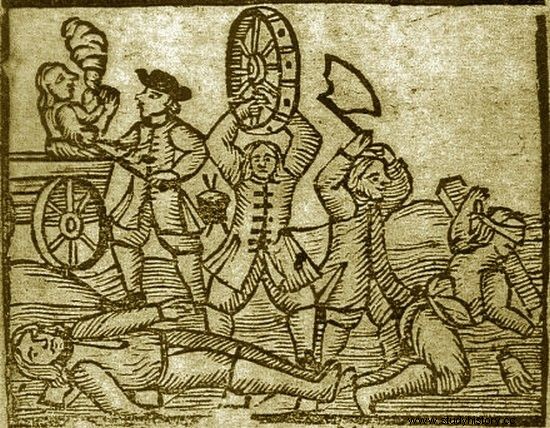
It happened that when a suicide had other crimes on his conscience, breaking the wheel was added to the repertoire of punishments.
The bodies of suicides were burned, drowned and hanged on the gallows. If, in addition, it was believed that by haggling their lives, the unfortunates wanted to escape punishment for other crimes they had committed, torture, such as breaking with a wheel, was also added to the repertoire of playing with corpses (read more on this topic).
5. They sent armed teams to steal a valuable corpse from the grave?
In the eighth century, the city of Mira, where Saint Nicholas lived, died and was buried, fell into the hands of Muslims. And in Christian Europe, relics were worth their weight in gold at the time. Every country, city or church dreamed of even the cube of the poorest saint. What about the whole body of a bigwig like the famous bishop!
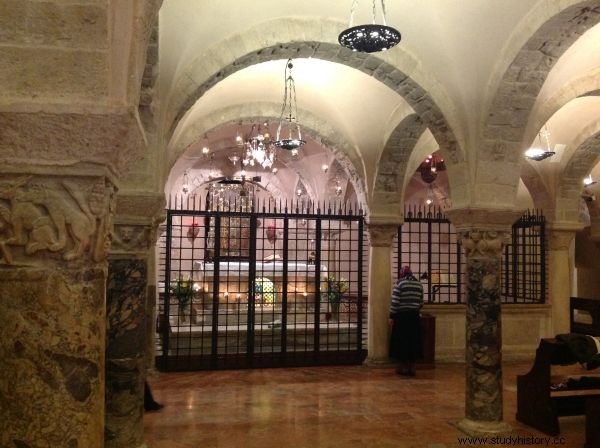
Crypt in the basement of the basilica. It is here that the remains of Saint Nicholas (photo:Kamil Janicki) are buried.
In the 11th century, two merchant cities decided to fight for this rarity:Venice and Bari. Each side hoped that the relics would bring her prestige and tangible income related to the pilgrimage business. At the same time, two expeditions were sent to kidnap the body of a Byzantine saint.
But the Barians had one advantage. Their city was then a real cultural melting pot, and the expedition itself was organized by specialists in this type of action - the Normans who ruled the city at that time. They were not playing with the subtlety. They burst into Santa's tomb with a whole armed crew and just took whatever they wanted (read more about it).
4. They ate the dead bodies of traitors?
The simultaneous punishment of hanging, beheading and quartering, exposing the body to public view, gutting, wandering the corpses all over the city, throwing the dogs to eat - in the Middle Ages, the fun continued long after the condemned man gave up his ghost. No wonder the executions were a lot of entertainment.
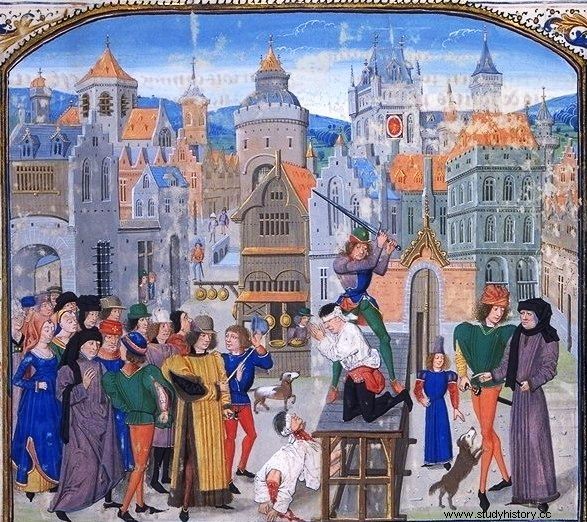
It often took a few blows with an executioner's sword to beheaded ... (painting from Froissart's "Chronicles", early 15th century, public domain).
But it is not everything! If you believe the chroniclers, the inhabitants of the Italian city of Todi simply ate the tyrant, Altobello di Chiaravalle, which was overthrown in 1500. In Milan, too, the body of a conspirator who was plotting against the prince was torn to pieces by a furious mob, and more than one had sunk their teeth into the traitor's heart.
In the 16th century, it was also believed that meat, blood and other bodily fluids from the bodies of convicts were an excellent remedy for many diseases (read more on this topic).
This article has more than one page. Please select another one below to continue reading.Attention! You are not on the first page of the article. If you want to read from the beginning click here.
3. They were joining gangs to excavate and sell corpses?
Armed guards over the graves and clever devices on the graves - this is how in the 18th century people defended themselves against the activities of "body snatchers"! Gangs of so-called "resurrectionists" circled cemeteries, digging up fresh bodies, then selling them to anatomy students.
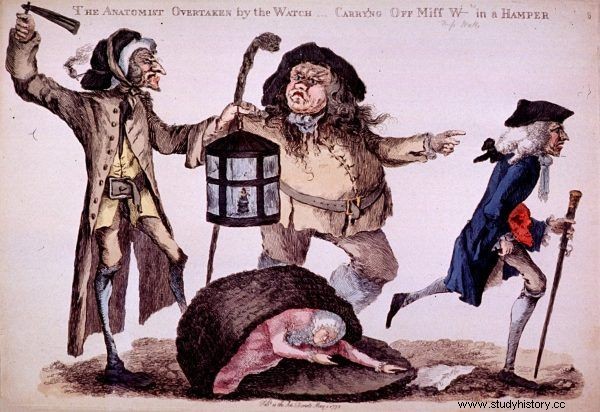
The theft of corpses was so common that special guards had to be employed to guard the graves at night. In the illustration by William Hunter, members of the guard chase away the medic who abandons the excavated body (source:public domain).
The demand was so great and there was so little legal means of getting a corpse for autopsy that the illegal trade of corpses was a golden business! For many, it was their only source of income (read more about it).
2. Raising the dead to testify in court?
According to medieval chroniclers, such an act of necromancy was to be committed by the most important Polish saint, Bishop Stanisław of Szczepanów. It is said that he lifted the deceased knight from the grave and resurrected him so that he could testify before the royal court.
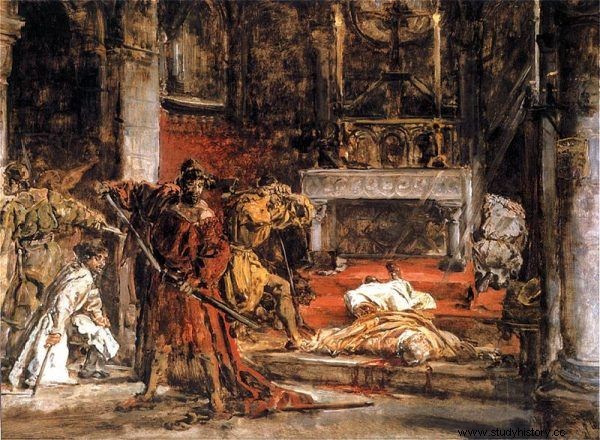
Artistic depiction of the murder of St. Stanisław by Jan Matejko (source:public domain).
When you don't know what's going on, it's about money. So it was this time. The case was related to finances, and more precisely to the deed of ownership. Stanisław had to prove in court that he had legally acquired the village of Piotrawin from a certain Piotr Strzemieńczyk.
The bishop did not have the necessary documents, and the deceased's family did not intend to take his word for it, hence the complaint to the king. In this situation, the saint decided that he had no peace in the soul of the deceased and summoned him from the underworld to confirm his version of events (read more on this topic).
1. They massacred human bodies with a scythe, sickle, hoe, spade ...
Polish peasants were superstitious, but also very inventive when it comes to struggling with imaginary fears. They knew more about the methods of fighting the living dead than the heroes of the series "The Walking Dead". Future zombies were flawlessly recognizable in their lifetime by fused eyebrows, atypical dentition, marks on the body, etc.
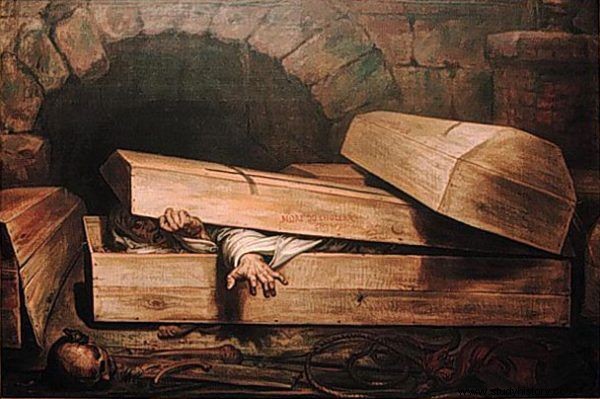
The fear of the sudden life of the dead has a very long history. Painting by Antoine Wiertz (source:public domain).
When cows began to fall in the village, someone died without a trace or the grain was not harvested as expected, the fun of digging up graves began. Although it was never 100% certain that the misfortunes were caused by a wraith coming out of the grave, it was always better to be safe than sorry.
Scythes, spades, and hoes were in motion. Their heads were cut off and the corpses were put at their feet. A sickle was put around the neck so that when it rose from the grave it decapitated itself. The bodies were turned over on their stomachs so that they would "bite into the ground" and not find a way out of the grave.
After making bloody pulp from the corpses of the neighbors, they quietly went home. After all, the danger has been averted (read more about it).
